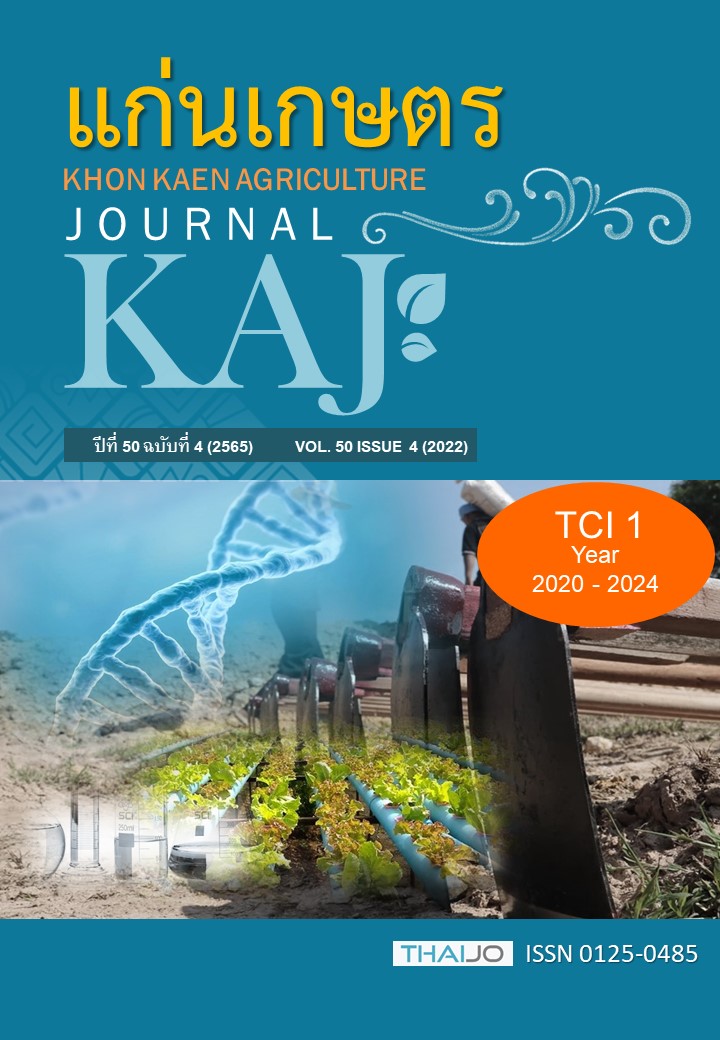ผลของความชื้นและระยะเวลาหมักต่อคุณภาพอาหารข้นเปียกสำหรับโคเนื้อ
Main Article Content
บทคัดย่อ
การควบคุมคุณภาพการหมักเป็นปัจจัยสำคัญสำหรับการใช้อาหารสัตว์จากวัสดุเหลือใช้ทางการเกษตรที่มีความชื้นสูง งานวิจัยครั้งนี้ศึกษาผลกระทบของระดับความชื้นและระยะเวลาหมักต่อองค์ประกอบทางเคมีและคุณภาพการหมักของอาหารข้นเปียก จัดปัจจัยทดลองแบบ 3 x 5 แฟคทอเรียลในแผนการทดลองแบบสุ่มสมบูรณ์ (3 ซ้ำ/ปัจจัยทดลอง) ปัจจัยทดลอง A คือ ระดับความชื้น (a1 = 40% a2 = 50% และ a3 = 60%) ปัจจัยทดลอง B คือ ระยะเวลาหมัก (b1 = 0 วัน b2 = 7 วัน b3 = 14 วัน b4 = 21 วัน และ b5 = 28 วัน) ผสมวัตถุดิบตามสูตรที่กำหนด โดยบรรจุในถุงพลาสติกในสภาพไร้อากาศ (30 กิโลกรัม/ถุง) ผลการทดลองครั้งนี้พบว่า ระดับความชื้นและวันหมักไม่มีอิทธิพลร่วมกันต่อวัตถุแห้ง อินทรียวัตถุ โปรตีนรวมและเถ้า (P > 0.05) ค่าการเปลี่ยนแปลงของวัตถุแห้ง (P < 0.01) และอินทรียวัตถุ (P < 0.05) มีแนวโน้มลดลงเมื่อวันหมักยาวนานขึ้น แต่โปรตีนมีค่าไม่แตกต่างกันทางสถิติ (P > 0.05) ค่าความเป็นกรด-ด่างมีค่าต่ำที่สุดเมื่ออาหารข้นถูกหมักนาน 7 วัน (P < 0.01) อาหารข้นเปียกหมักทั้งหมดมีคุณภาพการหมักที่ดีมาก จากผลทดลองครั้งนี้บ่งบอกได้ว่า ความชื้นที่เหมาะสมสำหรับการทำอาหารข้นเปียกอยู่ในช่วง 40% ถึง 60% อาหารข้นเปียกควรหมักอย่างต่ำ 7 วัน และสามารถถูกรักษาคุณภาพได้ยาวนาน 28 วัน
Article Details

อนุญาตภายใต้เงื่อนไข Creative Commons Attribution-NonCommercial-NoDerivatives 4.0 International License.
เอกสารอ้างอิง
ไกรสิทธิ์ วสุเพ็ญ, สุนทร วิทยาคุณ, เฉลิมพล เยื้องกลาง และไพวัลย์ ศรีนานวล. 2548. ผลของระดับความชื้นต่อคุณภาพของอาหารผสมครบส่วนหมัก ในการประชุมวิชาการครั้งที่ 43 สาขาสัตว์ สัตวแพทย์ศาสตร์ ประมง มหาวิทยาลัยเกษตรศาสตร์, กรุงเทพฯ.
บุญส่ง เลิศรัตนพงศ์, วิทยา สุมามาลย์, วิโรจน์ ฤทธิ์ฤาชัย และรำไพร นามสีลี. 2555. การศึกษาคุณภาพของพืชหมักในถุงพลาสติกดำที่อายุการเก็บรักษาต่างๆ. แหล่งข้อมูล: http://nutrition.dld.go.th/KnowledgeCenter/2555/boonsong%209-2555.pdf. ค้นเมื่อ 28 ธันวาคม 2564.
วารุณี พานิชผล, ฉายแสง ไผ่แก้ว, สมคิด พรมมา, โสภณ ชินเวโรจน์, จันทรกานต์ อรนันท์, วิโรจน์ ฤทธิ์ฤาชัย และวรรณาอ่างทอง. 2547. มาตรฐานพืชอาหารสัตว์หมักของกองอาหารสัตว์. กรุงเทพฯ: กองอาหารสัตว์ กรมปศุสัตว์ กระทรวงเกษตรและสหกรณ์.
AOAC, 1995. Official Method of Analysis, 16th ed. Animal Feeds: Association of Official Analytical Chemists, VA, USA.
Cai, Y., Y. Benno, M. Ogawa, S. Ohmomo, S. Kumai, and T. Nakase. 1998. Influence of Lactobacillus spp. from an inoculant and of Weissella and Leuconostoc spp. from forage. Applied and Environmental Microbiology. 64(8): 2982–2987.
Chauynaron, N., M. Bhuiyan, U. Kanto, and P. Iji. 2015. Variation in Nutrient Composition of Cassava Pulp and its Effects on in vitro Digestibility. Asian Journal of Poultry Science. 9(4): 203-212.
Kaiser, A. G., J. W. Piltz, H. M. Burns, and N. W. Griffiths. 2003. Successful Silage. Dairy Research and Development Corporation and NSW Agriculture, Australia.
Li Ying, H., N. Borjigin, and Z. Yu. 2017. Effect of inoculants and fibrolytic enzymes on the fermentation characteristics, in vitro digestibility and aflatoxins accumulation of whole-crop corn silage. Grassland Science. 63: 69–78.
Lounglawan, P., M. Khungaew, and S. Wisitiporn. 2011. Silage production from cassava peel and cassava pulp as energy source in cattle diets. Journal of Animal and Veterinary Advances. 10: 1007-1011.
McDonald, P., R. A. Edwards, J. F. D. Greenhalgh, and C. A. Morgan. 2002. Animal Nutrition. 6th ed. Longman Scientific and Technical, New York, NY.
Muck, R. E. 2010. Silage microbiology and its control through additives. Revista Brasileira de Zootecnia. 39: 183–191.
Park, H. S., K. C. Choi, J. H. Kim, M. J. So, W. H. Kim, and S. Srisesharam. 2015. Effect of Moisture Content on the Chemical Composition and Fermentation Quality of Italian Ryegrass Haylage. Journal of The Korean Society of Grassland and Forage Science. 35: 131–136.
SAS, 1998. User’s Guide: Statistic, Version 6, 12th ed. SAS Inst. Inc., Cary, NC.
Subepang, S., T. Suzuki, T. Phonbumrung, and K. Sommart. 2018. Enteric methane emissions, energy partitioning, and energetic efficiency of zebu beef cattle fed total mixed ration silage. Asian-Australasian Journal of Animal Sciences. 32(4): 548–555.
Wang, F. and N. Nishino. 2008. Ensiling of soybean curd residue and wet brewers grains with or without other feeds as a total mixed ration. Journal of Dairy Science. 91: 2380–2387.
Wang, J., J. Q. Wang, D. P. Bu, W. J. Guo, Z. T. Song, and J. Y. Zhang. 2010. Effect of storing total mixed rations anaerobically in bales on feed quality. Animal Feed Science and Technology. 161: 94–102.
WTSR. 2010. Nutrient Requirement of Beef Cattle in Indochinese Peninsula. Klungnanavitthaya Press, Khon Kaen, Thailand.
Yuan, X., A. Wen, S. T. Desta, J. Wang, and T. Shao. 2016. Effects of sodium diacetate on the fermentation profile, chemical composition and aerobic stability of alfalfa silage. Asian-Australasian Journal of Animal Science. 30: 804–810.


